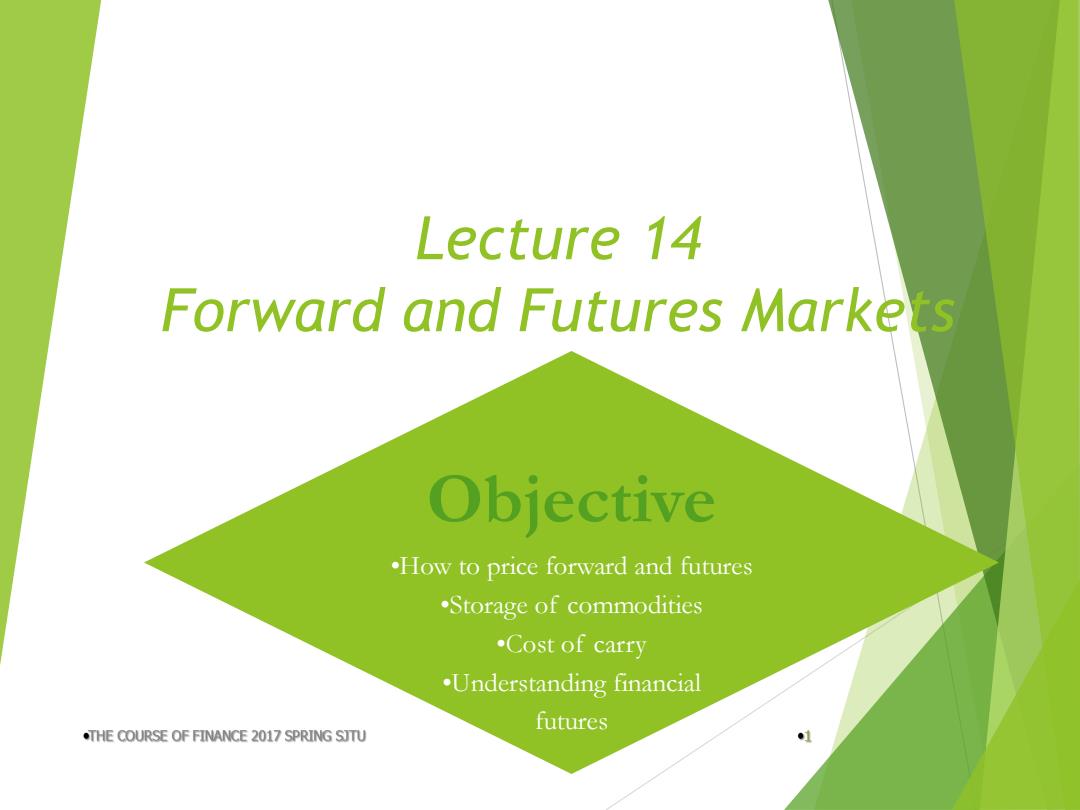
Lecture 14 Forward and Futures Markets Objective .How to price forward and futures Storage of commodities .Cost of carry .Understanding financial futures .THE COURSE OF FINANCE 2017 SPRING SJTU 1
Lecture 14 Forward and Futures Markets Objective •How to price forward and futures •Storage of commodities •Cost of carry •Understanding financial futures
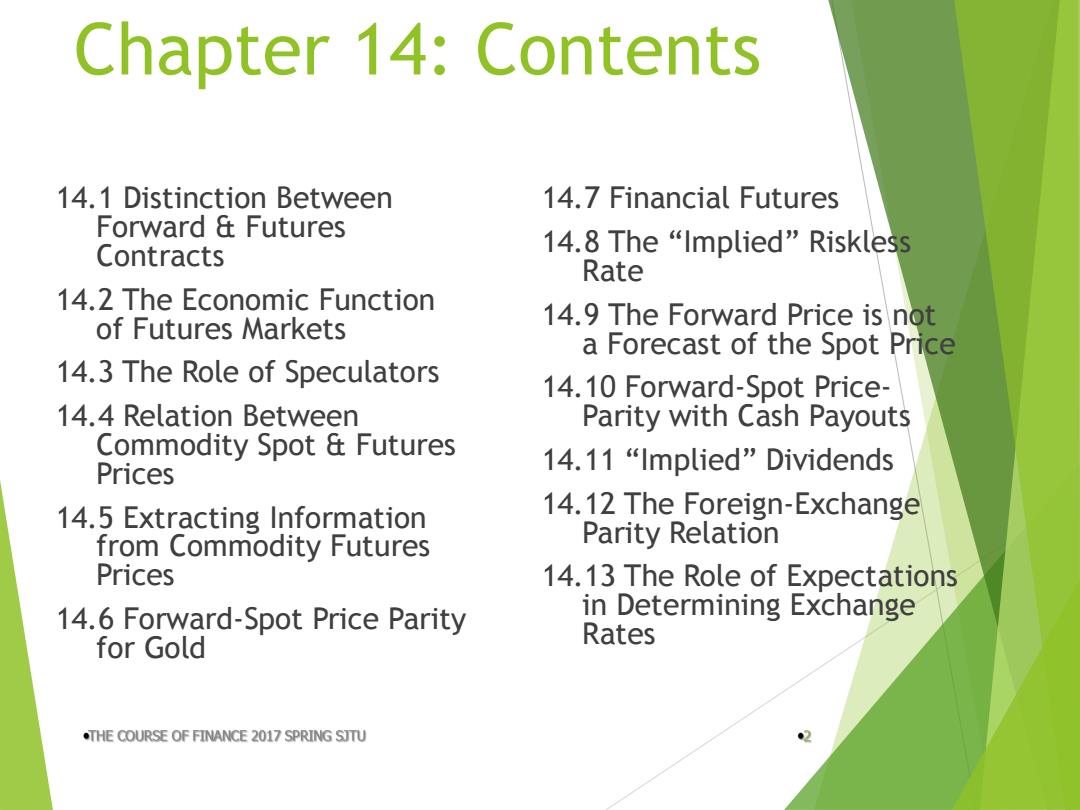
Chapter 14:Contents 14.1 Distinction Between 14.7 Financial Futures Forward Futures 14.8The“Implied”Riskless Contracts Rate 14.2 The Economic Function of Futures Markets 14.9 The Forward Price is not a Forecast of the Spot Price 14.3 The Role of Speculators 14.10 Forward-Spot Price- 14.4 Relation Between Parity with Cash Payouts Commodity Spot Futures Prices 14.11“Implied”Dividends 14.5 Extracting Information 14.12 The Foreign-Exchange from Commodity Futures Parity Relation Prices 14.13 The Role of Expectations 14.6 Forward-Spot Price Parity in Determining Exchange for Gold Rates .THE COURSE OF FINANCE 2017 SPRING SJTU
Chapter 14: Contents 14.1 Distinction Between Forward & Futures Contracts 14.2 The Economic Function of Futures Markets 14.3 The Role of Speculators 14.4 Relation Between Commodity Spot & Futures Prices 14.5 Extracting Information from Commodity Futures Prices 14.6 Forward-Spot Price Parity for Gold 14.7 Financial Futures 14.8 The “Implied” Riskless Rate 14.9 The Forward Price is not a Forecast of the Spot Price 14.10 Forward-Spot Price- Parity with Cash Payouts 14.11 “Implied” Dividends 14.12 The Foreign-Exchange Parity Relation 14.13 The Role of Expectations in Determining Exchange Rates
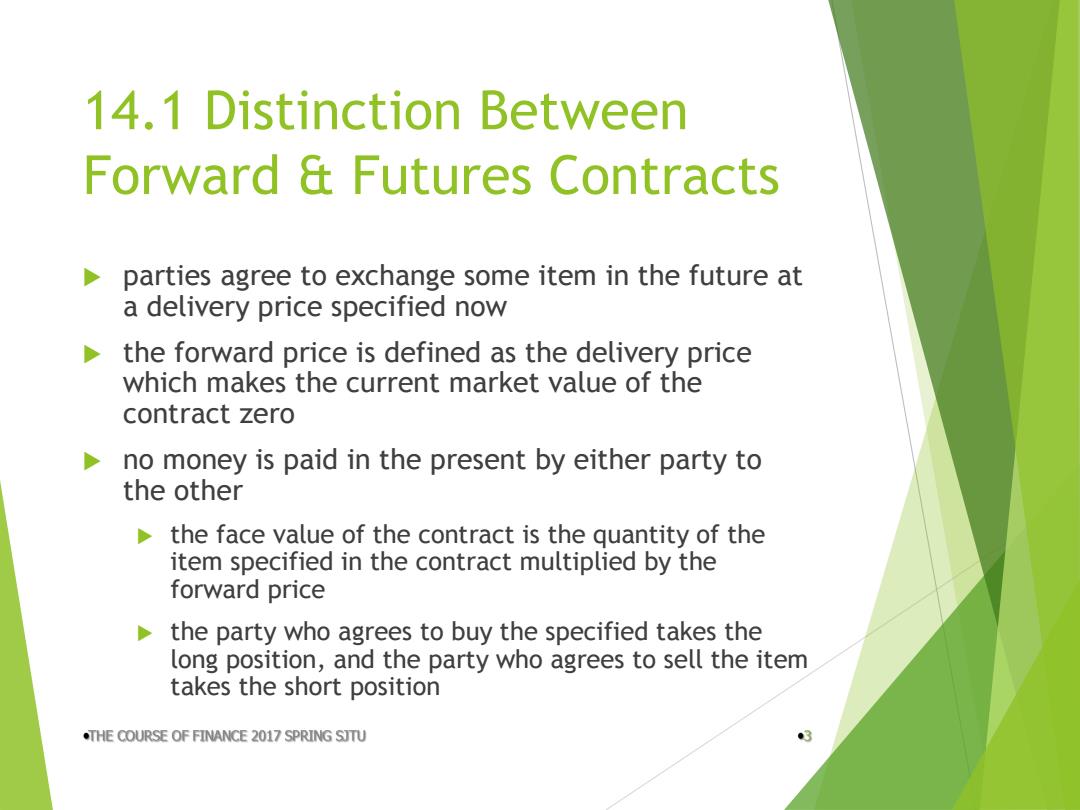
14.1 Distinction Between Forward Futures Contracts parties agree to exchange some item in the future at a delivery price specified now the forward price is defined as the delivery price which makes the current market value of the contract zero no money is paid in the present by either party to the other the face value of the contract is the quantity of the item specified in the contract multiplied by the forward price the party who agrees to buy the specified takes the long position,and the party who agrees to sell the item takes the short position .THE COURSE OF FINANCE 2017 SPRING SJTU
14.1 Distinction Between Forward & Futures Contracts parties agree to exchange some item in the future at a delivery price specified now the forward price is defined as the delivery price which makes the current market value of the contract zero no money is paid in the present by either party to the other the face value of the contract is the quantity of the item specified in the contract multiplied by the forward price the party who agrees to buy the specified takes the long position, and the party who agrees to sell the item takes the short position
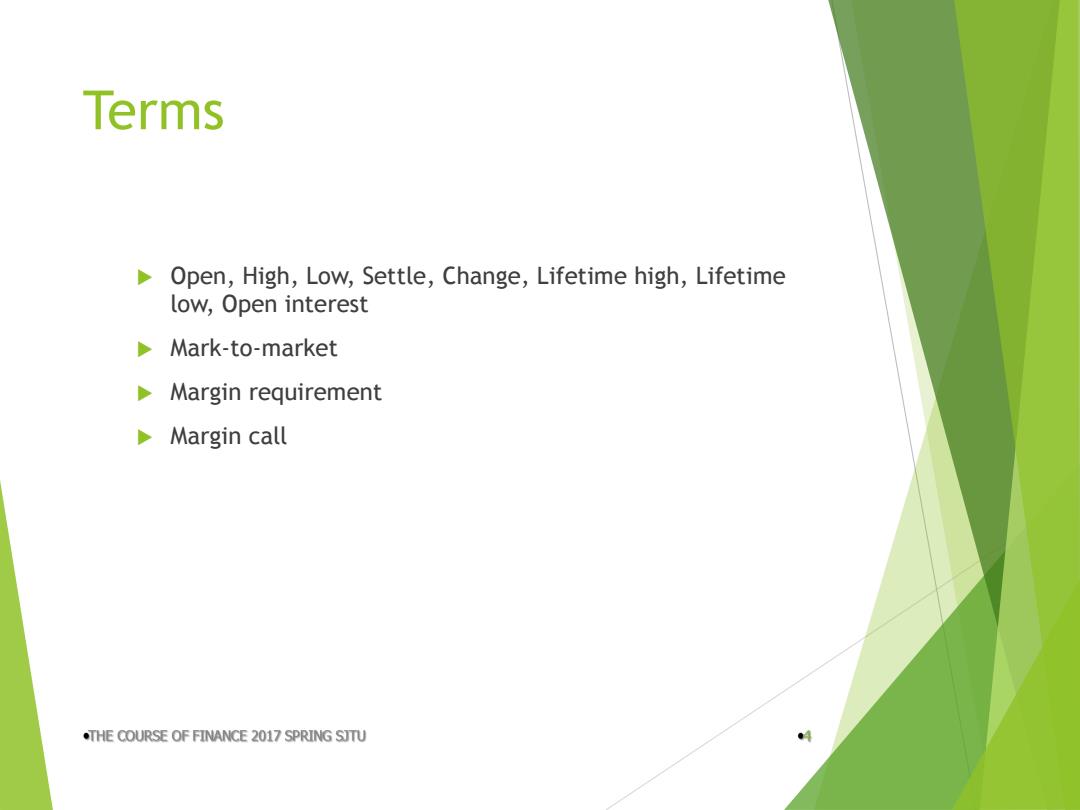
Terms Open,High,Low,Settle,Change,Lifetime high,Lifetime low,Open interest Mark-to-market Margin requirement Margin call .THE COURSE OF FINANCE 2017 SPRING SJTU
Terms Open, High, Low, Settle, Change, Lifetime high, Lifetime low, Open interest Mark-to-market Margin requirement Margin call
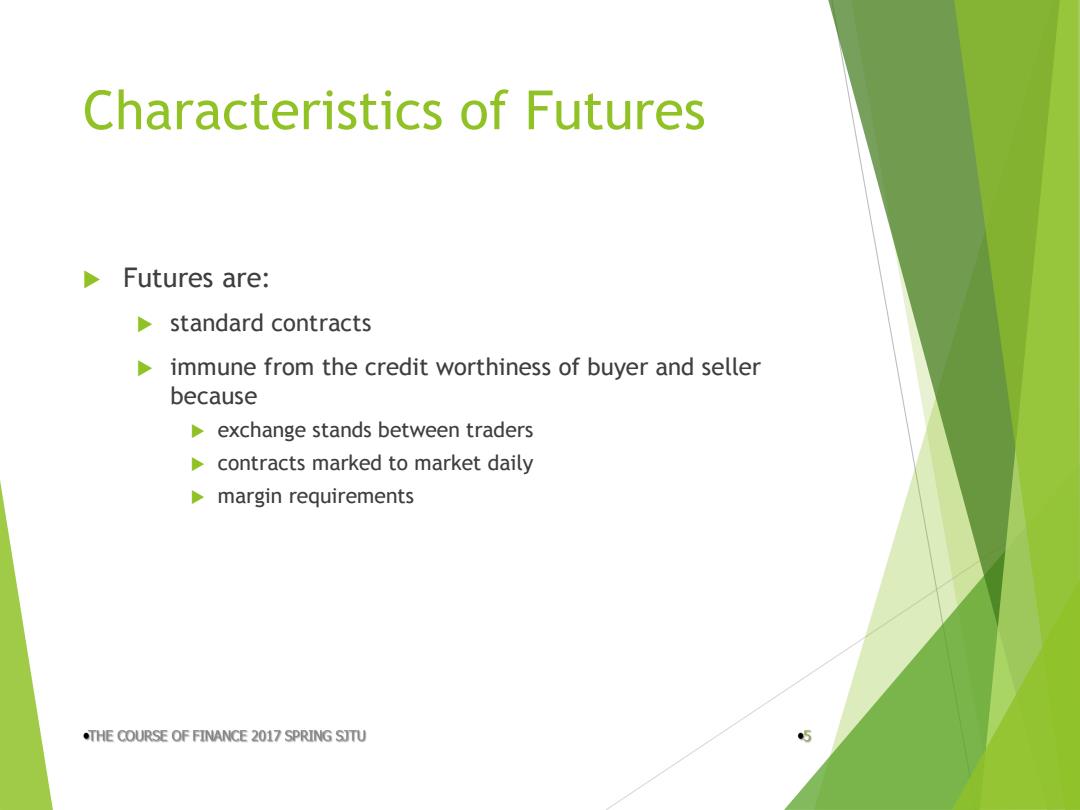
Characteristics of Futures Futures are: standard contracts immune from the credit worthiness of buyer and seller because exchange stands between traders contracts marked to market daily margin requirements .THE COURSE OF FINANCE 2017 SPRING SJTU
Characteristics of Futures Futures are: standard contracts immune from the credit worthiness of buyer and seller because exchange stands between traders contracts marked to market daily margin requirements

14.2 The Economic Function of Futures Markets The futures markets facilitate the re-allocation of exposure to commodity price risk among market participants But: .THE COURSE OF FINANCE 2017 SPRING SJTU 6
14.2 The Economic Function of Futures Markets The futures markets facilitate the re-allocation of exposure to commodity price risk among market participants But:
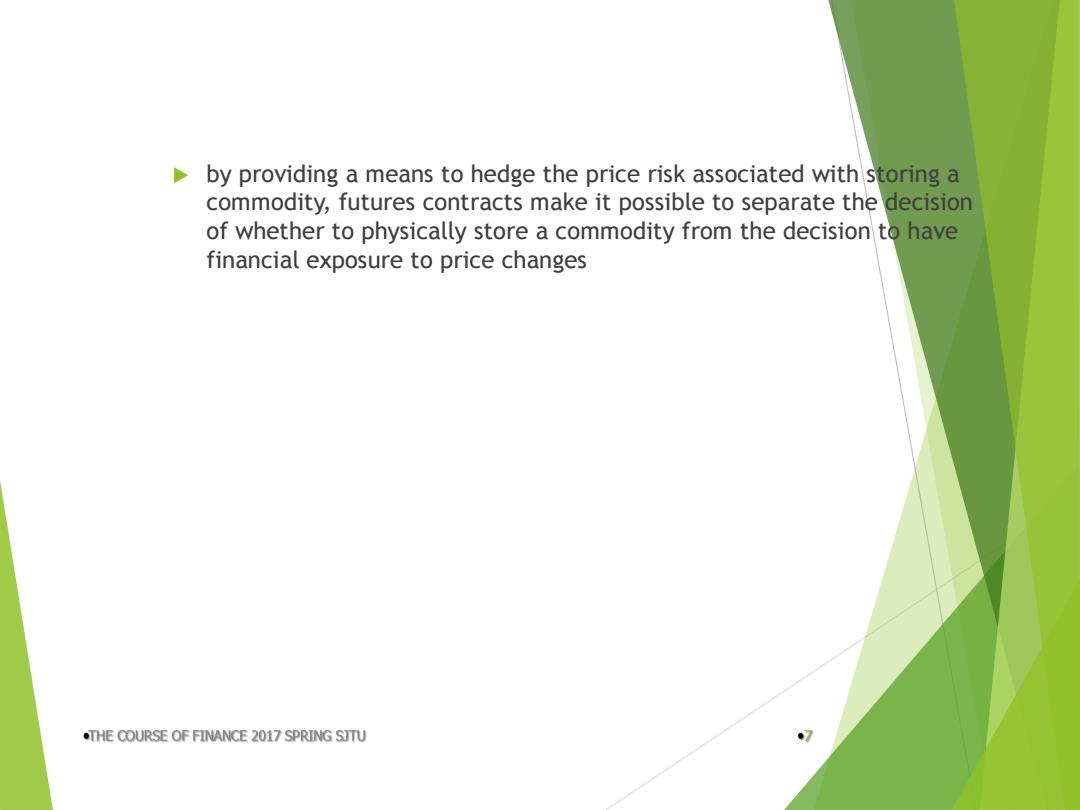
by providing a means to hedge the price risk associated with storing a commodity,futures contracts make it possible to separate the decision of whether to physically store a commodity from the decision to have financial exposure to price changes .THE COURSE OF FINANCE 2017 SPRING SJTU ●7
by providing a means to hedge the price risk associated with storing a commodity, futures contracts make it possible to separate the decision of whether to physically store a commodity from the decision to have financial exposure to price changes
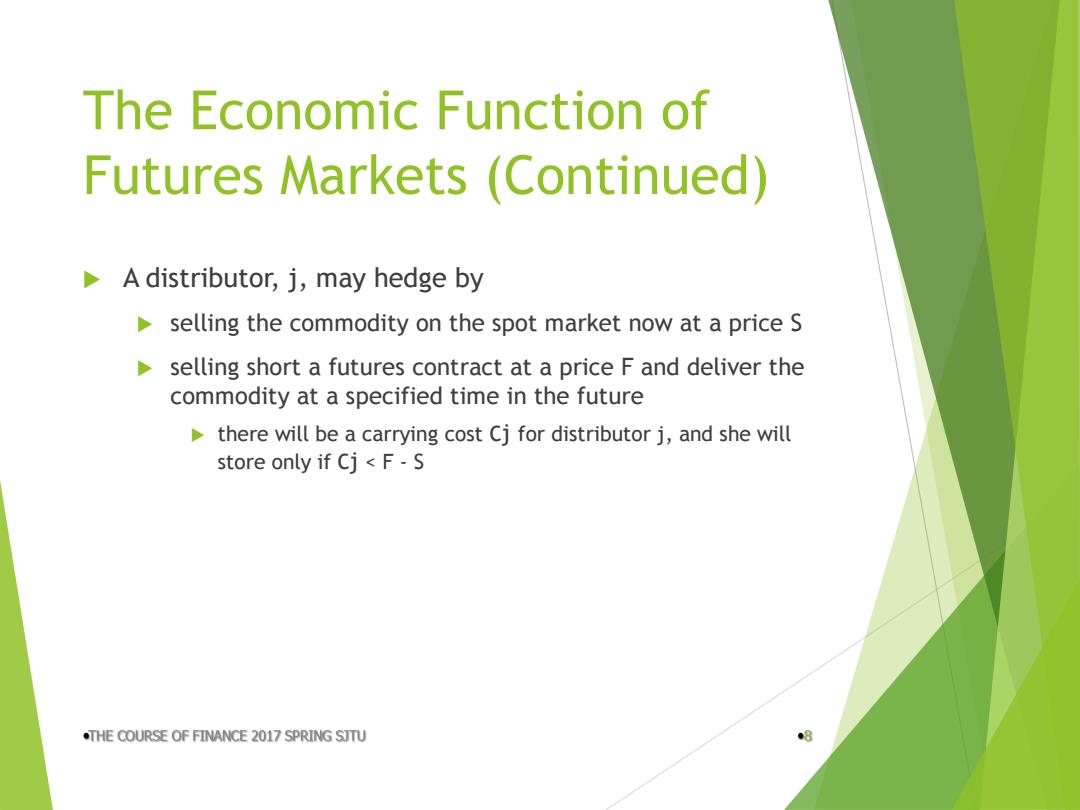
The Economic Function of Futures Markets (Continued) A distributor,j,may hedge by selling the commodity on the spot market now at a price s selling short a futures contract at a price F and deliver the commodity at a specified time in the future there will be a carrying cost cj for distributor j,and she will store only if Cj<F-S .THE COURSE OF FINANCE 2017 SPRING SJTU ●8
The Economic Function of Futures Markets (Continued) A distributor, j, may hedge by selling the commodity on the spot market now at a price S selling short a futures contract at a price F and deliver the commodity at a specified time in the future there will be a carrying cost Cj for distributor j, and she will store only if Cj < F - S

The Economic Function of Futures Markets (Continued) The difference between the futures price and the spot price,F-S,is called the spread,and governs how much wheat will be stored,and by whom .THE COURSE OF FINANCE 2017 SPRING SJTU 9
The Economic Function of Futures Markets (Continued) The difference between the futures price and the spot price, F - S, is called the spread, and governs how much wheat will be stored, and by whom

The Economic Function of Futures Markets (Continued) Suppose the commodity is wheat,and next year's crop is expected to be much higher than average,then futures prices may be lower than the spot,(the spread may be negative,nobody will store wheat .THE COURSE OF FINANCE 2017 SPRING SJTU 10
The Economic Function of Futures Markets (Continued) Suppose the commodity is wheat, and next year’s crop is expected to be much higher than average, then futures prices may be lower than the spot, (the spread may be negative,) nobody will store wheat